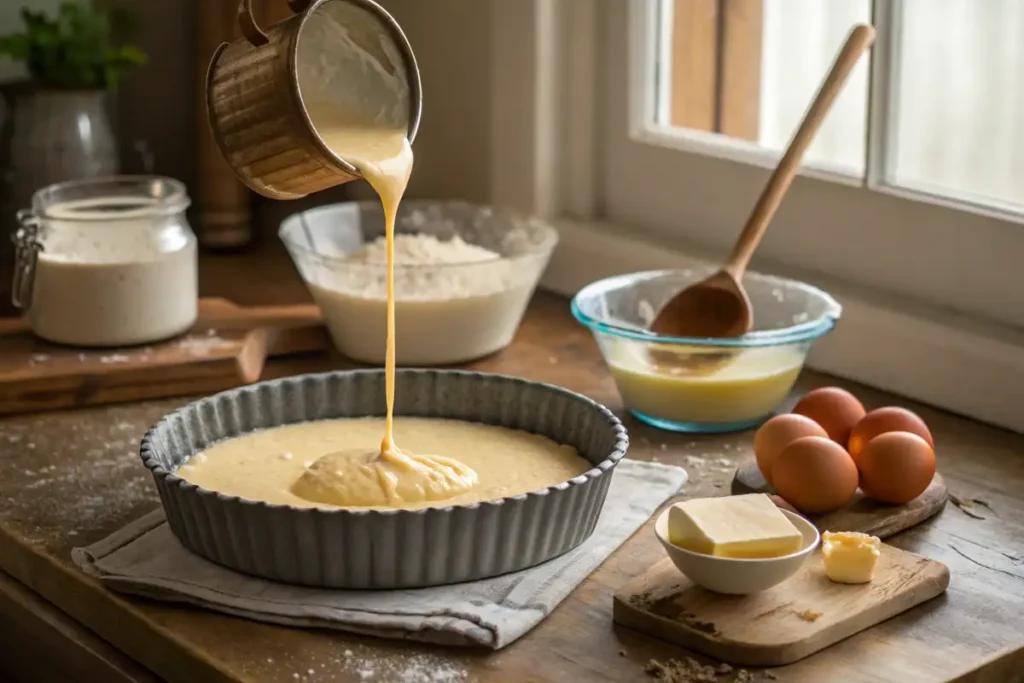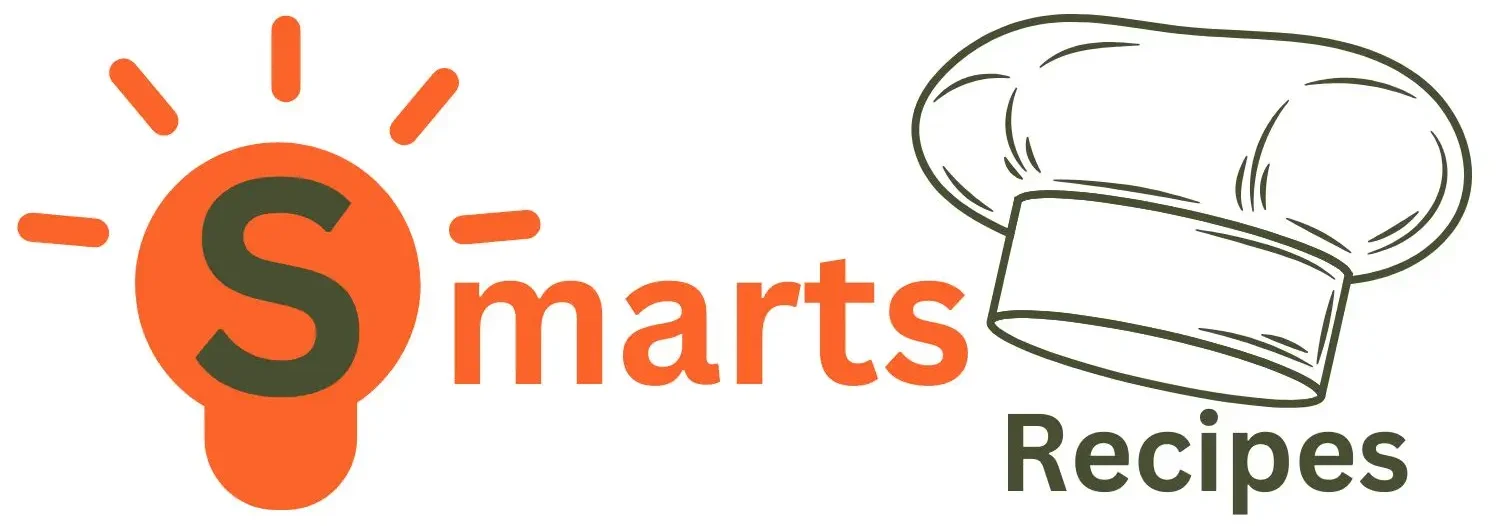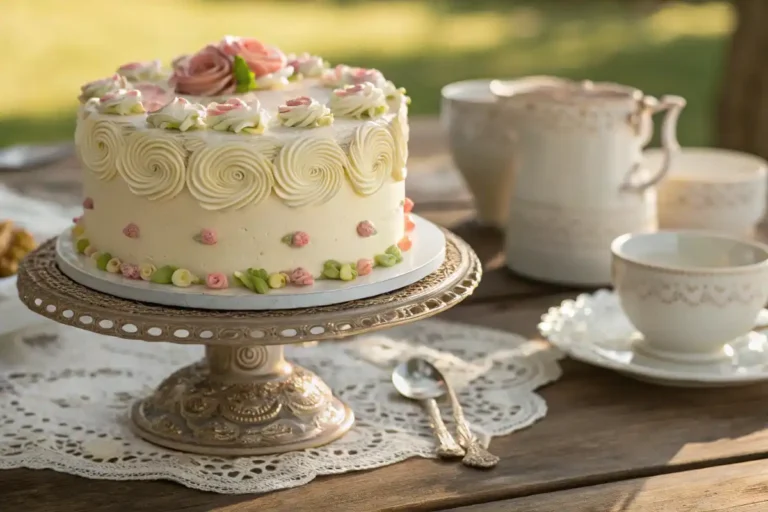Introduction
Vintage cake has captured the hearts of baking enthusiasts across the U.S. with its nostalgic appeal and timeless charm. In this guide, we explore everything you need to know about vintage cakes – from its rich history and essential ingredients to step-by-step instructions and creative serving suggestions. Whether you’re an experienced baker or just starting out, this article offers a comprehensive look at creating the perfect vintage cake.
1. A Journey into the History of the Vintage Cake
The story of the vintage cake is as rich and layered as the cake itself. Its origins date back to times when baking was an art form passed down through generations. Traditional recipes were cherished and adapted over time, leading to a style that represents not just a dessert, but a piece of history. Insert an image of an antique cake recipe book or vintage bakery.
From Tradition to Trend
Centuries ago, cakes were crafted with locally sourced ingredients and made to celebrate special occasions. Families often gathered around the kitchen, passing down secret recipes that gave birth to the vintage cake style. Today, these time-honored techniques are experiencing a resurgence, with modern bakers embracing the charm and depth of vintage recipes. This revival has introduced a delightful blend of nostalgia and innovation into contemporary baking.
The Cultural Significance of Vintage Cake
Beyond its taste, the vintage cake represents an era of craftsmanship and community. In many U.S. households, baking a vintage cake is not merely about following a recipe; it’s a tribute to heritage and tradition. Whether celebrated during holidays or family gatherings, the vintage cake is a symbol of warmth, love, and shared memories. Insert an image of a family enjoying a vintage cakes at a gathering.
2. Understanding the Vintage Cakes Style
Vintage cake is defined by its classic techniques, nostalgic ingredients, and timeless presentation. This style is characterized by the use of simple yet high-quality components, with recipes often relying on natural flavors and traditional methods. Let’s break down what makes a cake truly “vintage.”
Defining Features of a Vintage Cake
A vintage cake typically incorporates ingredients that were popular in earlier decades, such as real butter, natural extracts, and sometimes even vintage spices. The texture is usually moist and tender, and the decoration, while elegant, tends to be understated. These cakes often feature layers of delicate sponge and traditional fillings, reminiscent of bygone eras.
The Allure and Popularity of Vintage Cakes
There is a certain magic in the way Classic cakes evoke memories of simpler times. They remind us of family recipes and celebrations of the past. Today, vintage cakes have become a popular trend among bakers who want to relive classic flavors with a modern twist. Their popularity is fueled by social media, food blogs, and a growing desire for authentic, homemade treats. Insert an image of a beautifully decorated vintage cake on a rustic table.
3. Essential Ingredients and Tools for a Perfect Vintage Cake
Before diving into the baking process, it’s important to gather all the necessary ingredients and tools. Using quality ingredients not only enhances the flavor but also pays homage to the authenticity of the vintage cakes style.
Must-Have Ingredients
When preparing a vintage cake, the focus is on natural and unprocessed ingredients. Here are the essentials:
- High-quality all-purpose flour
- Fresh, unsalted butter
- Sugar (preferably organic)
- Fresh eggs
- Natural extracts such as vanilla or almond
- Leavening agents like baking powder and soda
- Seasonal spices (cinnamon, nutmeg) for added flavor
- Optional: Cream, buttermilk, or sour cream for moisture
Using ingredients that are as close to their natural state as possible is key to achieving that authentic vintage flavor.
Essential Tools and Equipment
To create a Classic cake that looks as good as it tastes, having the right tools is crucial. Equip your kitchen with these items:
- Mixing bowls of various sizes
- An electric mixer or stand mixer
- Measuring cups and spoons
- Whisks and spatulas
- Baking pans (round, square, or loaf pans depending on the recipe)
- A cooling rack for even cooling
- Decorative tools for icing and garnishing
Ensure your tools are clean and ready to use, as even a small imperfection can affect the final outcome of your cake.
4. Step-by-Step Instructions to Bake a Vintage Cake
Baking a vintage cake may seem daunting at first, but with a clear set of instructions, you’ll soon be enjoying a slice of nostalgia. Follow these detailed steps for the best results.
Step 1: Preheat and Prepare

Begin by preheating your oven to the correct temperature, usually between 325°F and 350°F (165°C to 175°C), depending on your recipe. Grease and line your baking pans with parchment paper to ensure the cake releases easily after baking. Insert an image of a preheated oven with a lined baking pan.
Step 2: Sift and Measure Ingredients
Sifting the flour and leavening agents together is a critical step that helps create a light, airy texture. Measure out each ingredient carefully, ensuring accuracy to maintain the balance of flavors and textures.
Step 3: Creaming Butter and Sugar
Using an electric mixer, cream the butter and sugar together until the mixture becomes pale and fluffy. This process is essential for incorporating air into the batter, resulting in a lighter cake. The creaming method is one of the key techniques in vintage baking.
Step 4: Incorporate Eggs and Extracts
Add eggs one at a time, beating well after each addition. Follow up with natural extracts like vanilla or almond. This gradual process ensures that the mixture remains smooth and emulsified, crucial for achieving a fine crumb.
Step 5: Fold in the Dry Ingredients
Gently fold in the sifted dry ingredients into the wet mixture. Be careful not to overmix, as this can lead to a dense cake. The folding technique is essential in preserving the light texture of the batter.
Step 6: Add Special Flavors and Spices
If your vintage cake recipe calls for spices or additional flavors, now is the time to incorporate them. Whether it’s a pinch of cinnamon or nutmeg, these flavors add a depth that enhances the overall taste of your cake.
Step 7: Pour and Bake
Transfer the batter into the prepared pans, smoothing the top with a spatula. Place the pans in the preheated oven and bake for the recommended time. Insert an image of a cake in the oven with a timer.
Step 8: Cooling and Layering
Once baked, remove the cake from the oven and let it cool in the pan for 10-15 minutes. Then, transfer the cake onto a cooling rack to cool completely. For layered vintage cakes, level the cake layers with a knife before adding fillings or frostings.
Step 9: Decorating Your Vintage Cake
Decorating is where creativity meets tradition. Use classic techniques such as simple buttercream icing or fondant decorations to keep the vintage look intact. Insert an image of a beautifully decorated vintage cake with delicate garnishes.
Step 10: Final Touches and Serving
Before serving, add any final touches such as a dusting of powdered sugar or a drizzle of homemade glaze. Allow your vintage cake to set, and then slice and serve with pride. Enjoy the aroma and flavor that transport you to a bygone era.
5. Expert Tips for Baking the Perfect Vintage Cake
Even seasoned bakers can benefit from a few extra tips when working on a vintage cake. Here are some creative insights to ensure your baking experience is smooth and your results are impressive:
Use Room Temperature Ingredients
Room temperature ingredients blend more evenly and produce a smoother batter. Allow eggs, butter, and dairy to come to room temperature before you begin mixing.
Embrace the Art of Patience
Baking a vintage cake is as much about technique as it is about timing. Let each step – from creaming the butter to folding in the dry ingredients – happen slowly and deliberately. Patience is key to unlocking the cake’s delicate texture.
Invest in Quality Tools
Using high-quality utensils and mixers can make a big difference. A reliable stand mixer, accurate measuring cups, and even a good set of spatulas ensure you work with precision and care.
Experiment with Flavors
While classic vintage recipes are timeless, don’t be afraid to experiment with subtle twists. Try incorporating a hint of citrus zest, a sprinkle of lavender, or a modern twist on a traditional spice blend to make your cake uniquely yours.
6. Creative Variations and Modern Twists on the Vintage Cake
Though the vintage cake is rooted in tradition, modern bakers are finding innovative ways to personalize this classic treat. Here are some exciting variations and creative twists that keep the essence of vintage while adding contemporary flair:
Fruit-Infused Vintage Cake
Enhance the natural flavors of a vintage cake by adding fresh or dried fruits. Consider incorporating strawberries, blueberries, or even dried apricots into the batter or as a layer between the cake tiers. The fruit adds a burst of color and flavor, making each bite a refreshing experience.
Decadent Chocolate Vintage Cake
For chocolate lovers, a vintage cake can be transformed by adding cocoa powder and rich chocolate ganache. The traditional texture meets modern indulgence, creating a dessert that is both comforting and luxurious.
Heritage-Inspired Vegan Vintage Cake
Modern dietary trends have given rise to vegan versions of classic recipes. Substitute dairy and eggs with high-quality plant-based alternatives while maintaining the integrity of the original recipe. The result is a vintage cake that’s both ethical and delicious.
Mini Vintage Cupcakes
Turn the traditional vintage cake into bite-sized cupcakes perfect for parties and gatherings. These mini treats are easier to serve and offer a charming presentation, allowing guests to enjoy a variety of flavors in one sitting.
7. Serving Suggestions and Pairings for Your Vintage Cake
A beautifully baked vintage cake deserves an equally thoughtful presentation. Here are some serving suggestions and pairing ideas to enhance your dining experience:
Classic Presentation Ideas
Serve your vintage cake on a vintage porcelain plate or rustic wooden board. Garnish with fresh berries, a dusting of powdered sugar, or a drizzle of homemade caramel sauce. These touches add visual appeal and invite your guests to savor every bite.
Beverage Pairings
Pair your vintage cake with complementary beverages. Coffee, tea, and even a glass of dessert wine enhance the overall flavor profile. A robust cup of coffee can balance the sweetness of the cake, while a fragrant herbal tea elevates the cake’s aromatic spices.
Seasonal Serving Ideas
For a fall twist, serve your vintage cake with spiced apple cider. In the spring, fresh lemonade or a fruity sangria can highlight the cake’s delicate flavors. Tailor your serving suggestions to the season to create a memorable dining experience.
Creative Plating and Garnishing
Think beyond the plate. Use vintage cake stands, elegant cake servers, and even edible flowers to create an enticing presentation. This artistic approach not only elevates the dessert but also becomes a conversation starter at your next gathering.
8. Troubleshooting Common Vintage Cake Baking Issues
Even the most experienced bakers encounter challenges. Here are some common issues you might face while baking a vintage cake, along with practical solutions:
Dense or Heavy Texture
If your cake turns out dense, ensure you are properly creaming the butter and sugar. Overmixing once the dry ingredients are added can also contribute to a heavy texture. Aim for a gentle fold to preserve air bubbles in the batter.
Uneven Baking
Uneven baking can occur if your oven’s temperature is not distributed uniformly. Use an oven thermometer to check for accuracy, and rotate your pans halfway through the baking process to promote even heat distribution.
Overly Dry Cake
An overly dry cake might result from overbaking. Always start checking for doneness a few minutes before the recipe’s stated time. Insert a toothpick in the center – it should come out with a few moist crumbs, not completely dry.
Frosting Troubles
If your frosting separates or becomes too runny, ensure that your ingredients are at room temperature and that you are using the correct ratios. Sometimes, adding a bit more powdered sugar can help stabilize the frosting.
9. Frequently Asked Questions (FAQs)
What is the vintage cake style called?
The vintage cake style is often referred to as “classic” or “old-fashioned” cake. It emphasizes traditional ingredients and methods passed down through generations, celebrating the heritage and simplicity of earlier baking eras.
What is the world’s most famous cake?
While opinions vary, many consider the Black Forest cake or the classic Victoria sponge to be among the world’s most famous. These cakes have a rich history and remain popular due to their timeless recipes and cultural significance.
Why are vintage cakes so popular?
Vintage cakes are popular because they evoke nostalgia and a sense of tradition. They remind us of family gatherings and simpler times, offering a comforting blend of classic flavors and time-tested baking techniques that appeal to both traditional and modern tastes.
Can we eat a 10 day old cake?
Generally, it is best to consume a cake within 2-3 days for optimal freshness. However, if properly stored in an airtight container and kept refrigerated, some cakes can be safely enjoyed for up to 10 days. Always check for signs of spoilage before consuming.
Conclusion: Embrace the Timeless Charm of the Vintage Cake
In conclusion, the vintage cake is much more than just a dessert – it’s a journey through time that blends tradition with modern creativity. From its rich history and carefully selected ingredients to the detailed steps in baking and decorating, every aspect of this cake is designed to deliver a memorable experience. Whether you’re recreating a cherished family recipe or experimenting with modern twists, the vintage cake offers endless possibilities for creating delectable treats that celebrate both the past and the present.
Now that you have the ultimate guide to vintage cake, it’s time to tie on your apron and bring a piece of history into your kitchen. Share your creations with friends and family, and let the timeless charm of the vintage cake inspire your next baking adventure. Happy baking!

